We live in a customer-centric world. Advances in consumer technology have been raising customer expectations about what constitutes a ‘good’ online experience for quite a few years now. They’re demanding consistency, interaction, and convenience. As a result, user feedback has become a fundamental criteria for growing a business and maintaining a satisfied customer base. So what’s the secret? User feedback enables organisations to listen to the customer and understand what they truly need. So rather than making assumptions and trying this or that until you get it right, organisations are simply asking their customers what they think, how they’re experiencing online journeys and what they believe can be improved.
Updated: February 2022
User feedback, however, is more than meets the eye. There are various strategies for collecting and analysing user feedback – all of which depend on your organisation’s goals, the digital channels you’re using (i.e. website feedback, mobile feedback and email feedback) and of course, how you wish to proceed with the feedback you’re given.
In this complete guide to user feedback, we will address the following:
- What is user feedback?
- Why is user feedback important?
- Types of user feedback
- Most popular user feedback metrics
- How to collect user feedback
- When to collect user feedback
- Where to collect user feedback
- Best user feedback tools
Today, consumers look to others’ opinions to decide how they should feel or think about a brand — and whether or not we should give them our business. This, my friends, has given rise to an economy driven by consumer feedback — what my colleague Joe Fuca calls the Feedback Economy.
Forbes
Ready to learn more about user feedback? Let’s get started.

Free White Paper: The future of Online Customer Feedback
Learn how you can leverage the power of online customer feedback to optimise websites and apps.
What is user feedback?
User feedback is essentially data collected from online visitors / mobile users which expresses their reaction to a product, service, or their overall experience on a website or mobile app. These insights are then used by various digital roles – such as digital marketers, UX designers, web analysts, mobile marketers, and more – to improve the customer experience.

Source: K2Systems
Why is user feedback important?
User feedback is important for a number of reasons. For starters, user feedback points out aspects of your product or service that need improvement. You can make assumptions all day about what your customers want and how you will give it to them, but in the end they’re voice is what matters most and they’re the ones who will give you the insights your business needs to make meaningful changes to your product and service offerings. By catering to your customers in this way, they’re also more likely to come back to your brand as it makes them feel involved and important. After all, listening to your customers helps you build loyalty.
Types of User Feedback
Crafting good user feedback surveys is a science, especially when we have multiple goals in place for collecting this feedback in the first place. Are you looking to gain insight into the performance of your email campaigns? Or are you more interested in learning about the overall customer experience of your website? There are various types of user feedback surveys that organisations can use to learn more about their users. Let’s take a close look at a few of these:
1. Customer Experience Feedback
A great customer experience (CX) can be the defining factor that sets a business apart from its competitors. CX has also become a top priority among customers when choosing a product or service. Customer feedback forms help users gain deep insights into the customer experience, which in turn provides them with the means to enhance their CX and bring in more customers.

Source: Beerwulf
Here are some examples of Customer Experience Feedback Surveys.
2. Email Campaign Feedback
Email feedback plays an important role in customer-centricity. By collecting this feedback within your email campaigns, you can provide a platform for two-way communication with your customers where they can share their thoughts and perceptions of your email(s) and the information you’ve provided. In other words, you as a marketer gain insight into what your readers truly value.
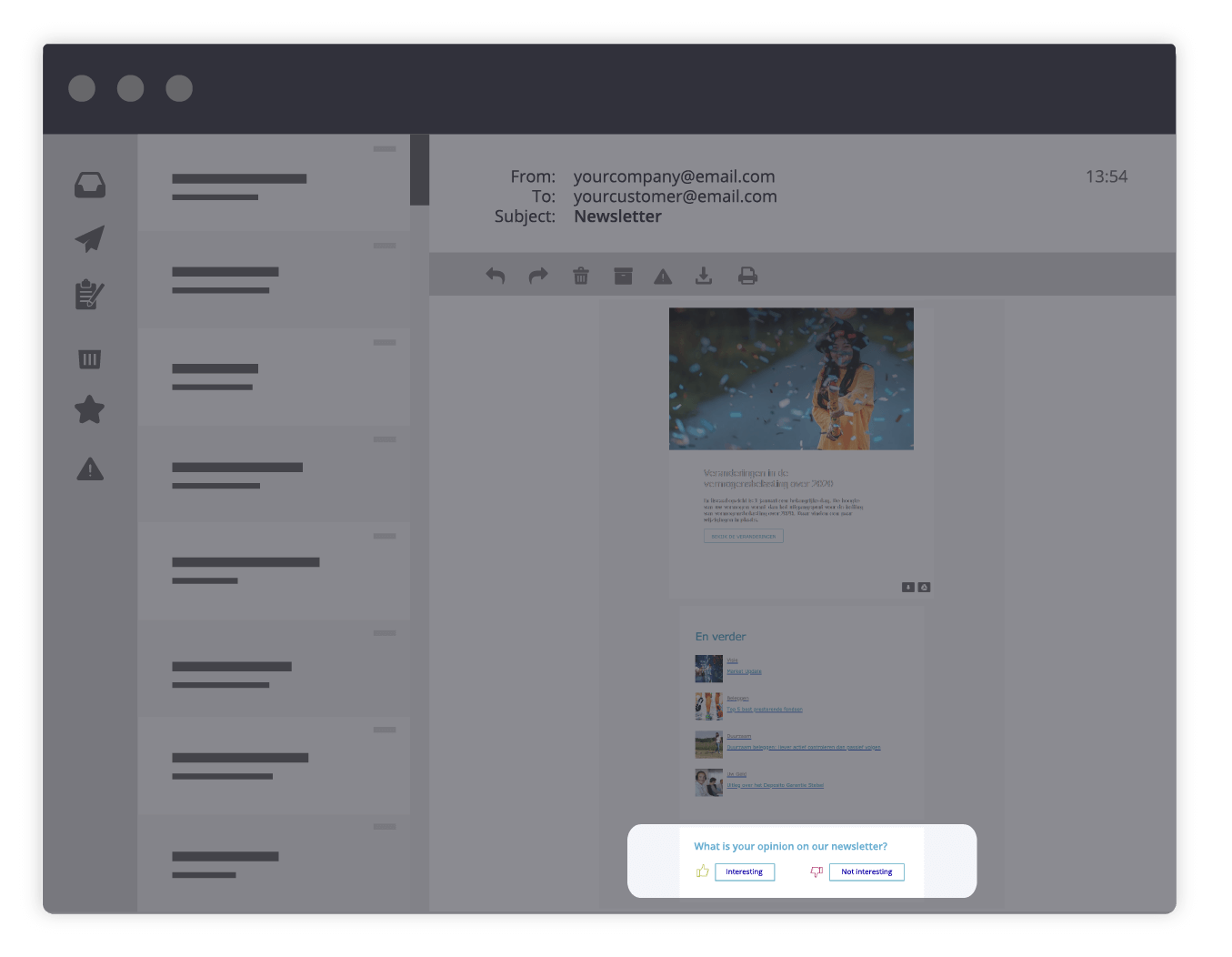
Source: Robeco
Here are some examples of Email Campaign Feedback Surveys.
3. Loyalty Feedback
Every business wants to create and maintain a loyal customer base. Tackling this challenge is done best by going directly to your customers and measuring their allegiance. Loyalty feedback surveys are great for collecting insights into the level of satisfaction your customers have with your product or service. Metrics such as Net Promoter Score (NPS) and Customer Satisfaction (CSAT) are very popular among digital-first organisations for measuring loyalty.
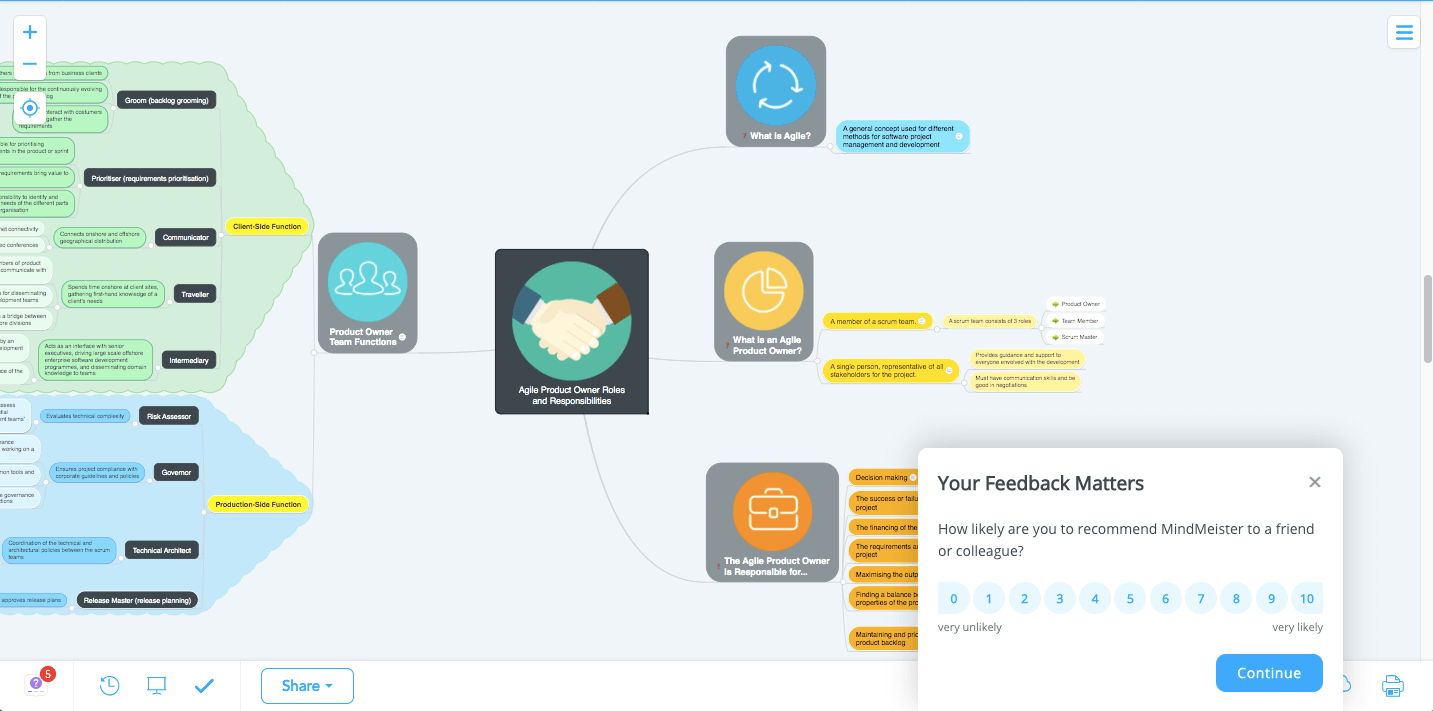
Source: MeisterTask
Here are some examples of Loyalty Feedback Surveys.
4. Mobile App Feedback
As the use of mobile continues to grow, mobile feedback has become a very powerful and necessary type of feedback. In fact, there’s an entire movement – ‘mobile first’ – which is pushing organisations to put more focus on the performance of their mobile apps. Customers have high expectations when it comes to the performance of these apps, making a good mobile experience a must.

Here are some examples of Mobile App Feedback Surveys.
Also be sure to check out this free white paper on Optimising the Mobile Experience with In-App Feedback.
5. Website Content Feedback
Website content largely defines the success of your business. So why wouldn’t you make it a priority to have the best website content out there? Surveys that measure content satisfaction give you in-depth feedback on how your customers experience your content. These surveys let you see how frequently a particular user visits your site, along with what they think of your homepage content, page navigation, product content and more.
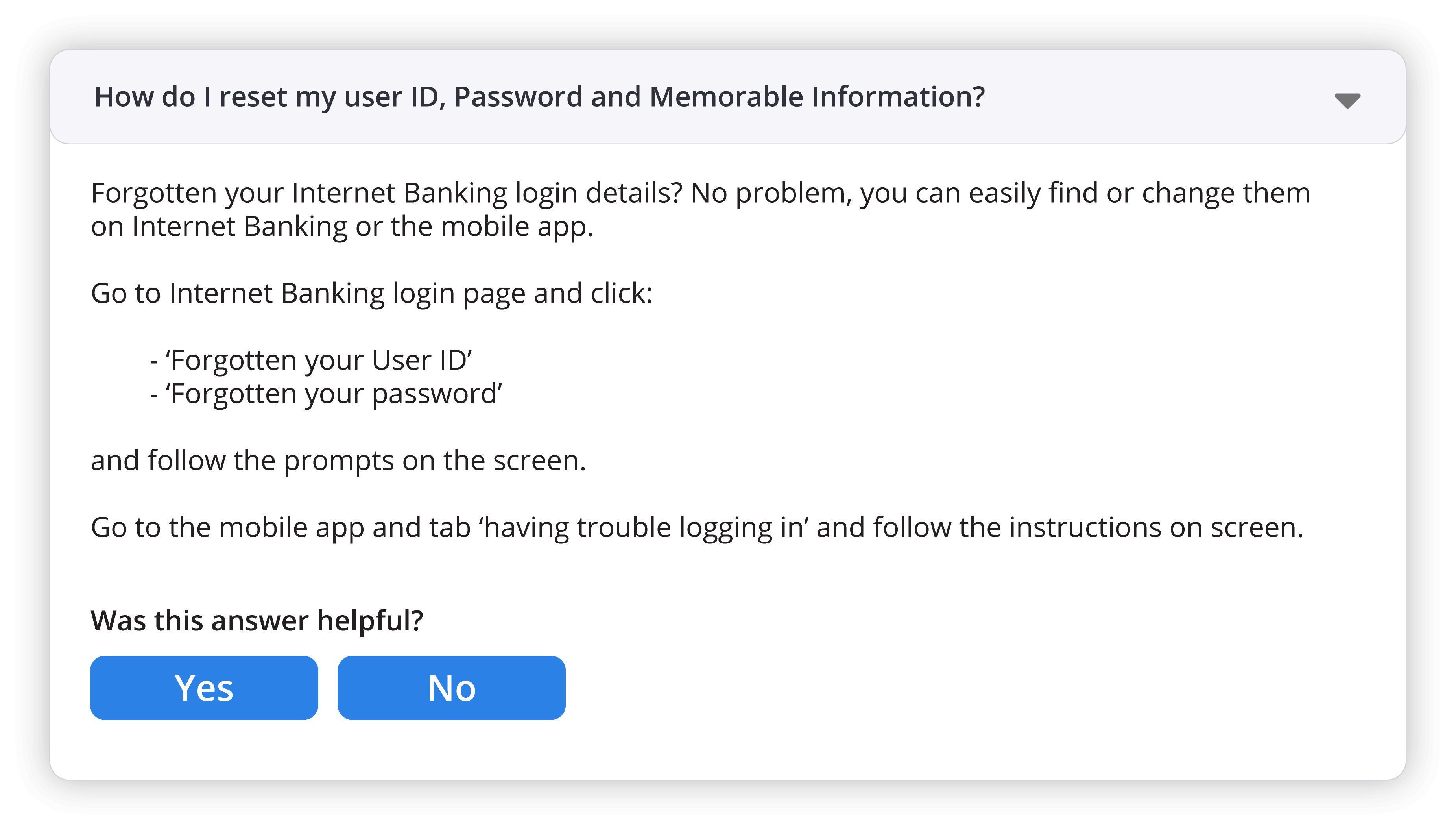
Source: TSB
Here are some examples of Website Content Feedback Surveys.
6. User Experience Feedback
User Experience is a measure of the overall experience as well as look-and-feel of your website. This type of feedback enables users to fill the gaps in their UX that are preventing customers from reaching their online goals, i.e. bugs, page errors, slow page loading, etc. In fact, user experience feedback is great for UX designers looking to improve certain pain points. For example, poor website design is an easy way to lose touch with your customers. It happens so often – whether a website / mobile app is difficult to navigate, or a certain button isn’t ‘clickable’ or visible within the checkout process. These are pain points that can cause a lot of frustration for your visitors / users.
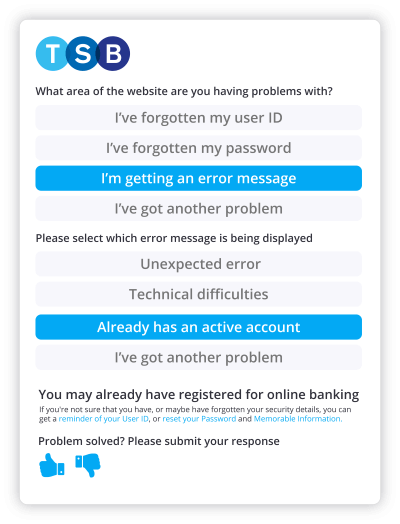
Source: TSB
Here are some examples of User Experience Feedback Surveys.
Looking for some additional resources to get started? Try these user feedback survey templates.
As you can see from the six types of user feedback surveys listed above, there are various feedback metrics used within each survey. A metric is a measurement unit that lets us quantitatively assess our online feedback. Each metric usually covers a different area or type of feedback so that digital marketers can quickly and easily make sense of the feedback data before them.
Most Popular User Feedback Metrics
When collecting and analysing user feedback, it’s important to use a good mix of quantitative and qualitative data. Therefore, many organisations collect certain user feedback metrics based on their goals and combine these with qualitative insights such as open comments. So which metrics are organisations using? Let’s take a look.
1. Net Promoter Score (NPS)
Net Promoter Score (NPS), perhaps one of the most popular loyalty metrics, is a great way of gauging customer loyalty online. It’s important to mention that NPS should never be used as a generic metric as it is only really effective when geared towards current and/or long time customers who are familiar with your brand. In other words it’s better to collect NPS scores from actual customers rather than anonymous visitors who have yet to build up any sort of relationship with your brand.

NPS can be measured in one of two ways: either to gather general insights on how the business is perceived by a customer (based on overall experience and the brand itself) or to gather insights based on a transaction the customer has made with your business. These two types of NPS surveys are referred to as Relationship and Transactional surveys.
2. Goal Completion Rate (GCR)
Goal Completion Rate (GCR) measures the number of visitors who have completed a specific goal on your website or mobile app. This feedback form question will typically be found in places where a customer is trying to make a purchase, using either a passive feedback method (user-initiated) or as exit feedback (a feedback form triggered based on exit intent). This metric should not be used on the homepage or landing page as this is just the beginning of the funnel and the goal cannot be completed at that point.

What’s great about this method is that when a customer fails to reach their goal on your website, you can ask why they did not reach their goal as well as ask them to leave their contact information behind, which turns them into a lead. These details provide you with the opportunity to rectify any issues in the funnel and help the customer convert. This is, therefore, a great feedback form question to use if you are looking to improve online sales funnels. Read more about collecting GCR in online funnels here.
3. Customer Effort Score (CES)
Customer Effort Score (CES) is a metric used to understand how much effort it took your customer to achieve his/her goal. This is a very critical metric because more often than not, high effort results in lower customer loyalty. One way to collect the CES is at the end of the funnel (e.g. once the customer has made a purchase). This is the most effective because although the customer made their purchase, there is otherwise no way of knowing how easy or difficult the process was for making that purchase. CES is also a good feedback form metric to use for improving online sales funnels.

4. Website Customer Satisfaction Score (CSAT)
Customer Satisfaction is essentially a measurement of how well your website meets the expectations of your customer. This could be measured based on a particular page of your website or alternatively, at an aggregated level (e.g. how satisfied are they with the entire website). Often companies measure CSAT using a number scale ranging from 1 to 10.

Obviously metrics alone will not be able to tell you much as this feedback only tells you what’s happening, but not why. So once you’ve collected the metrics you need to understand trends in your data, it’s important to make sure you also give visitors the opportunity to provide you with open comment feedback. Collecting this qualitative data will help you gain an understanding into the reasoning and motivation behind why your customer has provided negative or positive (quantitative) feedback.
We like to refer to it as the “why” as it exposes the root causes behind a behaviour. Why has your customer given you a low CSAT in your mobile app? Why have they decided to leave their shopping cart without making a purchase? Why are they idle on the page?
So now that you’ve gained an understanding of how user feedback surveys are set up, and which metrics you can use, let’s take a more practical approach…
How to collect User Feedback
Let’s dive into how your organisation can get started with user feedback.
Define your objectives. Before you get started, it’s important to define what the objective or goal of the survey is. In other words, what do you want to learn from it and why? Do you want to gain insight into customer loyalty? Or should the survey be more geared towards a particular online process (e.g. purchasing)? If you outline your objective(s) properly, it will help you come up with the right (and most relevant) questions to ask later on in the process.
Keep it short. We cannot stress this enough! Gone are the days when companies would send out page long surveys to customers to gauge their satisfaction. The reason being that the majority of your customers simply do not have the time to go through and answer these long and drawn out surveys. It’s a hassle for them and it has a high probability of causing what we call ‘survey fatigue’. So how do you know when your survey is too long?
Stand in your customers’ shoes for a second. Having to fill out a form of 20 questions is less than ideal. It’s actually much more beneficial to ask around 2 to 3 powerful and well-formulated questions. You’ll be surprised to see how much your response rates rise…
Interaction is key. Don’t make your questions too intricate – be clear in what you are asking so your customers understand. Always try to incorporate one or two questions that require an open-text answer. These will give you deeper insights into how your customers feel and can even generate ideas you haven’t thought of yourself.
Keep it relevant. There are appropriate questions and inappropriate questions to ask depending on your goal(s). For example, you wouldn’t ask someone to provide an Net Promoter Score (NPS) right as they’ve entered your website or before they’ve even become a customer. This goes to show that timing is rather important and surveys should be situational.
This also applies when using survey logic. Survey logic is when you trigger different follow up questions depending on the previous answer given. For example, if you ask for a Customer Satisfaction (CSAT) rating and the visitor provides that they are ‘Very Dissatisfied’, then you can ask them ‘why’. Why are they so dissatisfied? These kinds of relevant questions will give you deeper insights into what your customers are thinking.
Already aligned your objectives and come up with a plan of action? Then you’re ready to select a user feedback tool. There are a wide variety of software on the market, all of which cater to different goals. In this list, we’ve included all-encompassing, enterprise-level feedback solutions as well as the more simplified survey software to give you an idea of what’s out there.
When to collect user feedback
One of the best things you can do when it comes to collecting user feedback is to do so frequently. Digital products and services evolve fast and customer expectations even faster, so it’s important to stay ahead of the curve and iterate on your customer experience consistently using customer insights.
There are two different ways of collecting user feedback. Either passively via a static feedback button located somewhere on the page or in-app or actively via behavioural triggers. The latter is perhaps the most advantageous, however, in that this type of feedback survey gathers insights in the moment.
For example, many ecommerce organisations leverage active feedback surveys throughout the online ordering funnel. Using certain behavioural triggers (i.e leaving the browser, time on page, or clicking away from the shopping cart mid-purchase), these organisations can gather insights into why customers aren’t reaching their online goals in real-time.
Additionally, many organisations gather feedback post-purchase or after a visitor has converted. This type of feedback gives the organisation insight into overall customer experience and customer loyalty levels.
But that’s just for websites and mobile apps…Alternatively, if you are measuring email campaign performance and/or reader engagement, gathering feedback at the end of emails is the way to go. This feedback will help gauge what your audience thinks of your email and enable you to send them the right message.
Where to collect user feedback
The customer experience happens across multiple channels, meaning organisations need to have all of their bases covered if they want to measure the entire customer experience. Three critical places to gather this user feedback include the website, mobile apps and via email.
Website feedback
Collecting user feedback from your website is the most common way of gathering feedback. It will help you understand which areas of your website are performing well and which areas could be improved upon, i.e. certain pages and funnels that are key to the customer journey. There are many ways to collect website feedback including a generic feedback survey which is accessible via some or all pages on the website (A.K.A. a passive feedback survey), at the bottom of a webpage via an embedded survey, or as a popup / slide-in survey (A.K.A. an active feedback survey).

Example of a customer experience feedback survey (in the passive form).
Mobile feedback
Additionally, you can collect user feedback from your mobile app(s). Mobile feedback is one of the few solutions that has a direct impact on the mobile experience. This is because in addition to measuring hard metrics such as Net Promoter Score and CSAT, mobile feedback can also provide your organisation with the sentiment behind user behaviour, through mobile survey elements such as open comments. This qualitative data provides a deeper understanding of your mobile users, thus equipping your organisation with the means to cater more effectively to their needs.
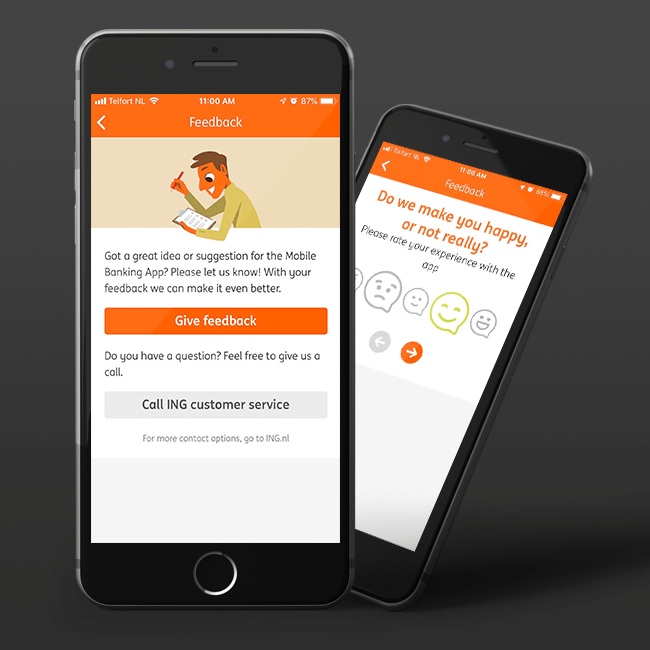
Email feedback
Email feedback plays an important role in customer-centricity. By collecting user feedback within your email campaigns, you are providing a platform for two-way communication with your customers where they can share their thoughts and perceptions of your email(s) and the information you’ve provided. In other words, you as a marketer gain insight into what your readers truly value and can boost the customer experience as a whole. Email feedback can be collected in various ways including, email signature feedback, email feedback surveys and email campaign feedback.
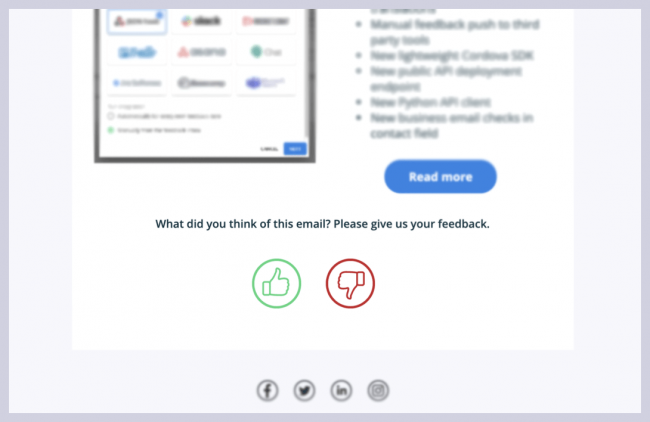
Best User Feedback Tools
Here is our selection of the top 10 best user feedback tools.
1. Mopinion
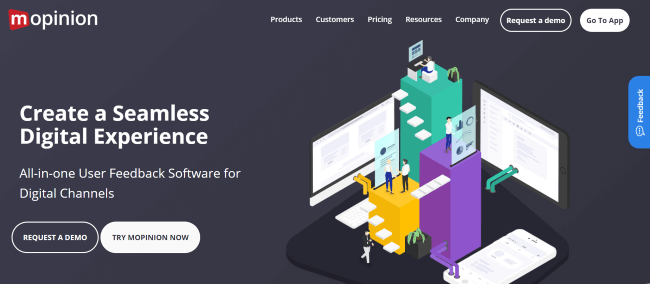
Mopinion is an all-in-one user feedback tool that helps organisations collect and analyse website, mobile and email campaign customer feedback. It has an easy-to-use interface, with which users can build, design and configure feedback forms however they like. Mopinion users can also target specific groups of visitors with feedback forms and gain insights into why they are struggling to convert. Once collected, feedback items can be visualised in customisable dashboards and charts for advanced analyses. Additionally, digital teams can share and take action on these feedback items in a timely manner with the help of smart alerts.
TypeForm

Typeform is an online user feedback software with a very user-friendly interface that allows users to put surveys together themselves. As a respondent, the process of filling in a survey goes quite smoothly. The free version of Typeform, also known as the ‘CORE plan’ includes free features such as unlimited questions and answers, data export options, custom-designed themes as well as readily-made templates and basic reporting features.
3. Feedbackify

By way of a drag-and-drop editor, Feedbackify allows users to easily create feedback forms themselves. Installation is also very easy. All you have to do is copy and paste the code they provide you with into your website’s HTML and it’s ready to go. Your visitors can provide a rating as well as submit comments, including compliments and suggestions. Within this customer feedback tool, you can view all feedback received in a dashboard in real-time as well as filter by category and sub-category.
4. InMoment

InMoment, a cloud-based customer experience optimisation platform, offers multiple solutions including Social Reviews & Advocacy and Employee Engagement solutions as well as a Voice of the Customer (VoC) platform. It’s VoC platform allows for user feedback collection, online reporting, real-time alerts and occurrence management. The platform combines the survey data it collects with customer data from other sources such as CRM, social and financials.
5. UserSnap

Usersnap is a popular user feedback tool for collecting visual feedback. It is run via a JavaScript tag on your website. Users can take notes or add comments and highlight certain elements with a circle. It can be integrated with various tools such as Slack, Trello, Basecamp and Jira.
6. Qualaroo (by ProProfs)

Qualaroo (recently acquired by ProProfs) is a tool you can use to create short, easy and accessible surveys that usually appear at the bottom of your screen in a widget. You can easily conduct polls amongst your visitors and ask simple questions such as “What is your profession?”. Also this tool includes a feature to set rules on where and which questions should be triggered. The feedback form will in that case be displayed subtly, popping up from the bottom of your screen.
7. OpinionLab
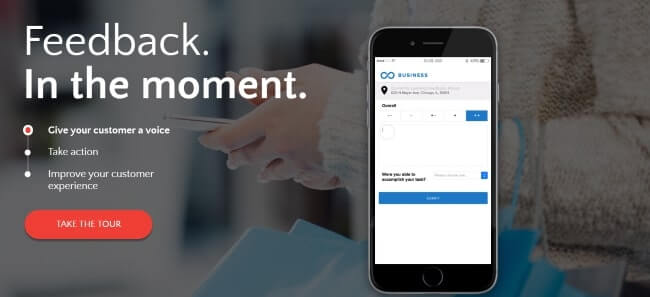
A Verint company, Opinionlab is a popular Voice of the Customer (VoC) platform that collects user feedback via standard surveys. Initially this tool focused on website feedback but it is now positioned a lot broader. This tool now also gathers feedback from other channels such as contact centres and shops. In addition, OpinionLab allows you to collect page-specific website feedback, much like the rest of the tools above.
8. Survicate

Survicate is a well-known web survey solution that lets users trigger targeted surveys across various funnels of the website. Alternatively, you can send out email questionnaires to different customers using digital CX metrics such as NPS, CSAT, CES, and more. Survicate also allows users to perform some analysis activities including dashboarding, NPS analysis and exporting feedback to XLS or CSV.
9. Feedier

Feedier is an accessible Feedback platform that lets teams get instant clarity on their users’ experiences and future needs. Create playful feedback forms that can be automated and sent during your users’ key touchpoints. Feedier’s dashboard lets you group individual feedback into live journeys. Validate key decisions using easy-to-share visual reports that connect with your existing workflows. Integrate your feedback forms into your website or app by generating embedded code or share it with email/sms campaigns to your audience.
10. Qualtrics

Qualtrics is an Experience Management Platform which offers various data collection methods such as website/mobile feedback, email surveys and social feedback for actionable customer, market and employee insights. Though this solution is more of a traditional survey software, it does offer a dedicated solution for digital. Users have access to their own role-based dashboards and can view results in trend vs. target charts. There is also a closed loop ticketing feature that notifies users of customer interactions, such as the presence of a detractor.
Having trouble deciding which user feedback software is best for your organisation? Check out this Buyer’s Guide for choosing the right user feedback software. This guide helps you determine which features you will need (i.e. triggering options, types of user feedback surveys and dashboarding capabilities), the technical requirements you should consider, data privacy requirements, and much more.
Time to go after those user insights!
We hope this guide has helped you or at least given you some inspiration for jump starting your new user feedback program. As you can see, there’s a lot to consider. But once your feedback program is up and running, you’ll be glad you started. User feedback is so critical to the success of your digital channels and to creating a loyal customer base in the long run!
Curious how organisations like yours leverage user feedback?
Check out these customer stories
![[:en]Complete Guide to User Feedback[:]](https://media.mopinion.com/wp-content/uploads/2020/10/28110305/feedback-guide-cover-300x106.jpg)







